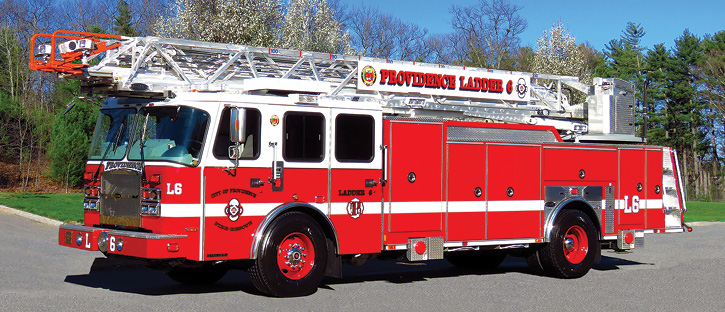
Aerial manufacturers are turning out vehicles with shorter jack spreads than in the past, allowing the rigs to get into tight spaces and operate in limited-access areas. Fire Apparatus & Emergency Equipment looks at the various models of aerials being made with narrower jack spreads than typical and examines their effectiveness in actual practice.
E-ONE
Joe Hedges, product manager for chassis and aerials at E-ONE, says the narrowest jack spread E-ONE has, exclusive of boom aerials, is on its Metro 100 single-rear-axle 100-foot aerial ladder with no tank or pump. “It’s a criss-cross under-slung jack design with an 11-foot jack spread that sticks out about 1½ feet from each side of the truck,” Hedges points out. “The operator can set up in very tight spaces without relying on short jacking, firefighters don’t have to navigate around a vertical jack tower common on H jack designs, and the compact under-slung design provides additional compartmentation stowed over the outrigger area.”

1 An E-ONE HP78 aerial ladder sets up in tight quarters at a housing complex. (Photos 1-2 courtesy of E-ONE.)

2 E-ONE built this Metro 100 aerial ladder, which uses four criss-cross under-slung outriggers with a jack spread of 11 feet, for the Providence (RI) Fire Department.
Hedges notes that the Metro 100 can be built on both Cyclone and Typhoon chassis; locates its four jacks behind the cab and behind the rear wheels; and has a 220-inch wheelbase with a reduced rear overhang, a 45-degree cramp angle that allows easy navigation in very congested areas, a raised rear departure angle, fuel tanks ahead of the rear outriggers, and a travel height as low as 10 feet 7 inches.
More by Al Petrillo
- Corrosion Protection for Fire Apparatus
- APUs Save Departments Run Time, Wear/Tear on Apparatus
- Al Petrillo Archive
On shorter aerials that are designed as quints, jack spread gets a bit wider, Hedges says, with a 75 footer with a 210-inch wheelbase or a 78-foot aerial ladder quint with a 220-inch wheelbase having a 16-foot jack spread using a single set of H-style jacks at the rear of the turntable. “When short jacked, our Advanced Aerial Control System (AACS) allows movement to the short-jacked side when the aerial is fully retracted and straight up to allow rotation and then deployment off the front or rear and 10 degrees left and right on the short-jacked side,” he says. “Our 100-foot platform on tandem rear axles has four criss-cross under-slung jacks with a 15-foot 6-inch spread and also can be short jacked down to an 11-foot 2-inch jack spread when small vertical-mounted cylinders are used at the end of the outriggers. We call them stab jacks, and they extend down and lift and level the vehicle in the short-jack position.”
PIERCE MANUFACTURING INC.
Tim Smits, senior sales manager of aerial products for Pierce Manufacturing Inc., says Pierce offers a number of aerial stabilizer options. “For example, we built a 100-foot Ascendant steel aerial ladder on an Arrow XT chassis for the Newton (MA) Fire Department that has a 12-foot jack spread and a dry tip load of 500 pounds and 250 pounds when flowing water,” Smits says. “In our Ascendant class of aerials, we have one set of H jacks, with others being down jacks.”
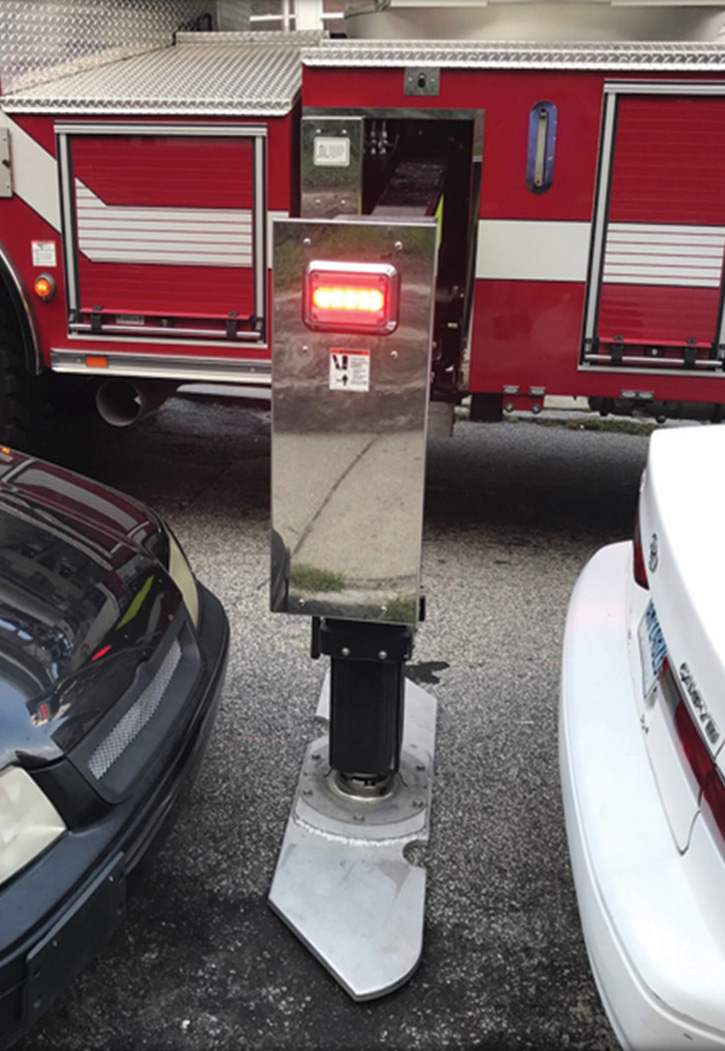
3 A Pierce aerial H-style jack sets up between two parked cars. (Photos 3-4 courtesy of Pierce Manufacturing.)
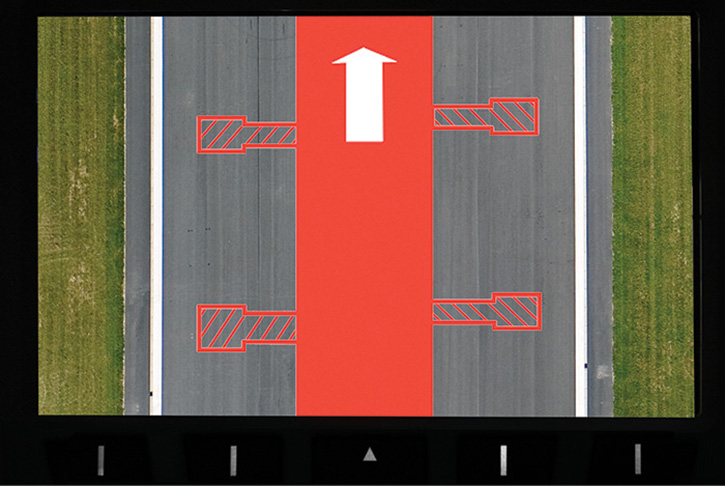
4 Cameras on Pierce’s aerials show an operator exactly where the vehicle’s jacks will be placed.
Smits notes that cameras on Pierce’s aerials show an operator exactly where the stabilizers will be placed. “A driver can see precisely where the jacks will be deployed so he can see if a manhole cover, or curb, or car is going to be in the way or if he needs to get in closer to a sidewalk,” Smits observes. “Instead of getting four jacks out, the aerial can be stabilized with only one jack fully out because a rotation interlock prevents the operator from going beyond the bounds of a short-jacked side of the truck. Besides the camera, there’s a multiplex screen in the cab that shows the grade to be set up on with green, amber, and red lights indicating if the terrain will allow a safe setup.”
On an Ascendant 110-foot single-rear-axle platform steel aerial, Smits adds, the jack spread is 14 feet with the aerial having a 750-pound tip load dry and 500-pound tip load wet flowing at 1,500 gallons per minute (gpm). Smits notes that Pierce’s 100-foot aluminum aerial ladder on a tandem axle has an 11-foot stabilizer spread with a 750-pound dry tip load and 500 pounds wet.
KME
Jason Behler, sales application engineer for KME, says KME recently introduced a 103-foot aerial ladder Tuff Truck that has a 12-foot jack stance. “There are four H-style jacks on the truck, two at the front of the body and two at the rear of the pedestal, and the short jack spread is especially useful in alleys and other tight roadways,” Behler says. KME’s 109-foot aerial ladder has a 14-foot jack spread, he notes, as does the 79-foot aerial ladder that often is configured as a quint.
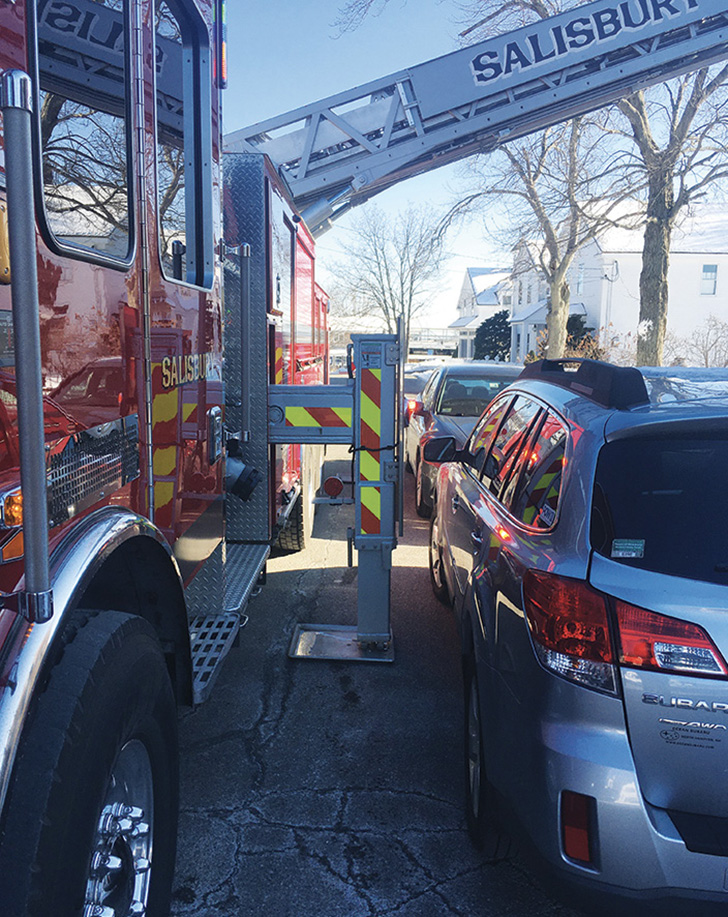
5 This 103-foot aerial Tuff Truck that KME built for the Salisbury (MA) Fire Department is shown with its jacks fully out, set up in tight quarters. (Photos 5-6 courtesy of KME.)

6 This KME aerial touch screen shows the aerial in operation with the warning that the rig is short jacked. The aerial controls will prevent the ladder from operating on the short-jacked side.
KME has an ICAN multiplex system on its aerials that monitors short jacking and prevents aerial rotation on the short-jacked side, Behler points out. “You can go about five degrees onto the short-jacked side before it limits you,” he says, “but you still have full operational capability on the fully jacked side.” A 10-inch touch screen on KME aerial turntables gives the operator a snapshot of the setup; shows the short-jacked side; and, when rotating, gives real-time information about where the aerial is being positioned. “We also offer a 360-degree camera and do an overlay of the truck with the stabilizers on the screen so the operator has a good view of where the jacks will end up while he’s sitting in the cab, able to see obstructions like cars, curbs, and dumpsters.”
FERRARA FIRE APPARATUS
Paul Christiansen, aerial sales manager for Ferrara Fire Apparatus, says all Ferrara’s aerials have the ability to be short jacked and can be set up as tight as 13 feet 2 inches. “Typically on our two- and three-section aerials, the 57- and 77-footers, they only have rear jacks, but the 77-foot aerial can add straight down front jacks, which helps in leveling the vehicle when facing downhill,” Christiansen says. “On our LP-102 aerial ladder, we use rear H-style jacks and two straight-down front jacks. The arrangement makes it easier to set up in a crowded city, so you only have to look for two landing spots for the jacks instead of four.”
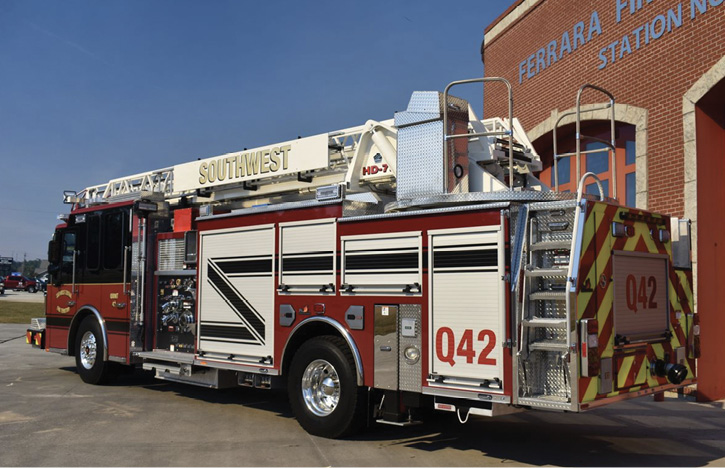
7 This HD-77 aerial ladder built by Ferrara Fire Apparatus for the Southwest Central (IN) Fire Territory uses two H-style rear jacks that can be set up as tight as 13 feet 2 inches. (Photos 7-8 courtesy of Ferrara Fire Apparatus.)
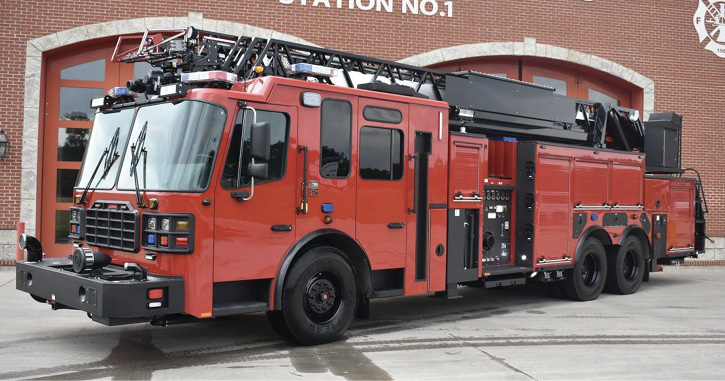
8 Ferrara built this LP-102 aerial ladder that uses two H-style rear jacks and two straight-down front jacks for the Garden City (NY) Fire Department.
Ferrara also offers a laser unit to allow the driver to sight in where the outriggers with land. “We also have an auto-leveling system that has an indicator in the cab to tell the operator if the truck will be level enough for full use of the aerial,” Christiansen notes. “If you’re operating on a slope or too steep of a grade, it might limit the capabilities of your aerial. The indicator shows a green light for 100 percent capability, amber for 50 percent, and red for no setup.”
HME AHRENS-FOX
David Rider, business development aerial product specialist for HME Ahrens-Fox, notes that his company’s HAF80L 80-foot aerial and its 111-foot HAF111L tandem-rear-axle aerial both have 14-foot jack spreads using four H-style jacks and carrying 500-pound tip loads. “We have envelope control on all of our aerial products that allows the driver to operate over a short-jacked side safely,” Rider says. “The jacks are located at the front and rear of the body, two behind the pump module and two behind the rear wheels.”
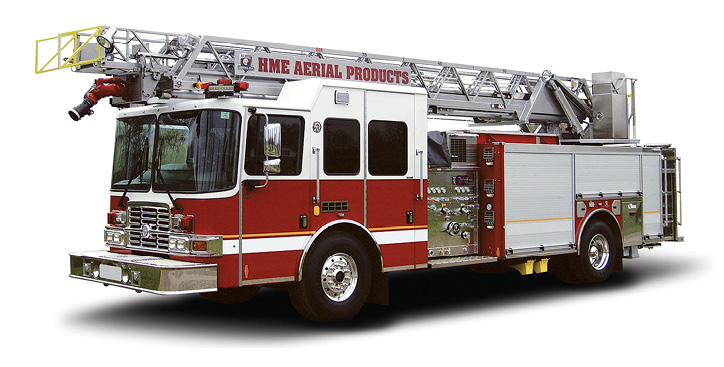
9 The HAF80L 80-foot aerial ladder made by HME Ahrens-Fox has a 14-foot jack spread using four H-style jacks. (Photos 9-10 courtesy of HME Ahrens-Fox.)

10 This 111-foot HAF111L aerial ladder that HME Ahrens-Fox built for the Milford (NH) Fire Department has four H-style jacks with a spread of 14 feet.
ROSENBAUER
Brandon Whittaker, aerial sales manager for Rosenbauer, says Rosenbauer makes the 55-foot Articulating Cobra Platform (ACP) that has an 11-foot 9-inch jack spread “that allows the truck to be set up in very confined spaces. Wheelbase options are as short as 170 inches, and if a department wants to make it a quint with a 2,000-gpm pump and 500-gallon water tank, the wheelbase is 216 inches with an outside turning radius of 36.5 degrees and an inside turning radius of 44 degrees left and right.”
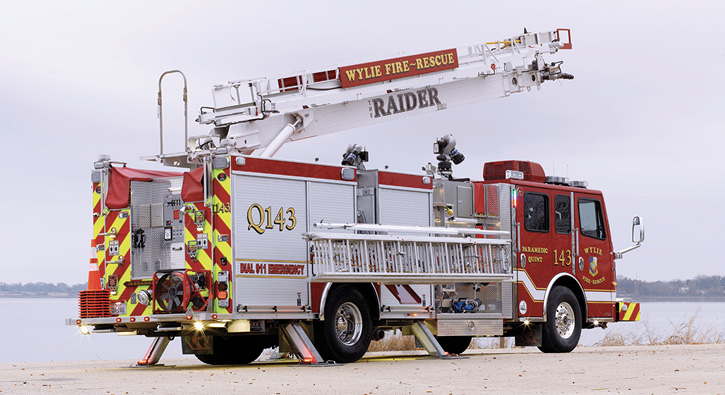
11 Rosenbauer built a 55-foot ACP with a jack spread of 11 feet 9 inches for the Wylie (TX) Fire Department. (Photos 11-12 courtesy of Rosenbauer.)
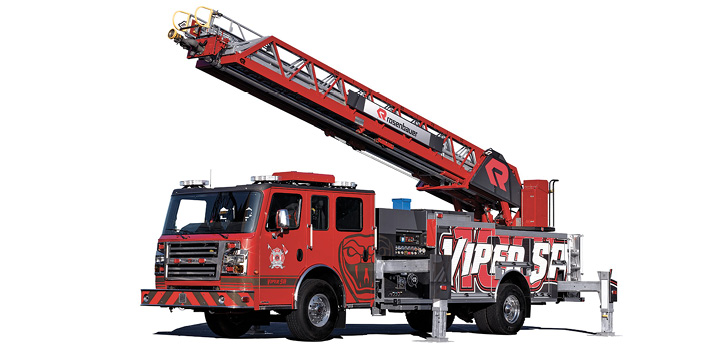
12 Rosenbauer’s 100-foot SA Viper aerial has a 16-foot 6-inch jack spread on four H-style jacks and can be short jacked to 9 feet 9 inches.
Whittaker adds that all Rosenbauer aerials can be short jacked and still operate on the short-jacked side through Smart Aerial envelope control. “An operator can set up the aerial with jacks onto curbs, sidewalks, between cars, on manholes, and in some instances still allow full 360-degree rotation with full tip loads depending on extension and reach,” he says. Rosenbauer’s 100-foot SA Viper aerial on a single rear axle has a 16-foot 6-inch jack spread on four H-style jacks, he adds, “but can be short jacked to 9 feet 9 inches to allow unique positioning of 360-degree rotation with a 45-foot reach and 500-pound tip load wet or dry.”
SUTPHEN CORP.
Zach Rudy, director of sales at Sutphen Corp., says Sutphen’s aerials use out-and-down H jacks. “Our tightest jack spread is 16 feet, but we are able to integrate short jacking on them, allowing full use of the aerial on the opposite side of the short jack and five degrees on each side of the short-jacked side,” Rudy says. He notes that Sutphen’s 95-foot aerial ladder on a tandem axle has an 18-foot jack spread, while the 100-foot aerial tandem rear axle has a 20-foot jack spread. On both models, two H jacks are at the center line and two are straight down at the rear.”
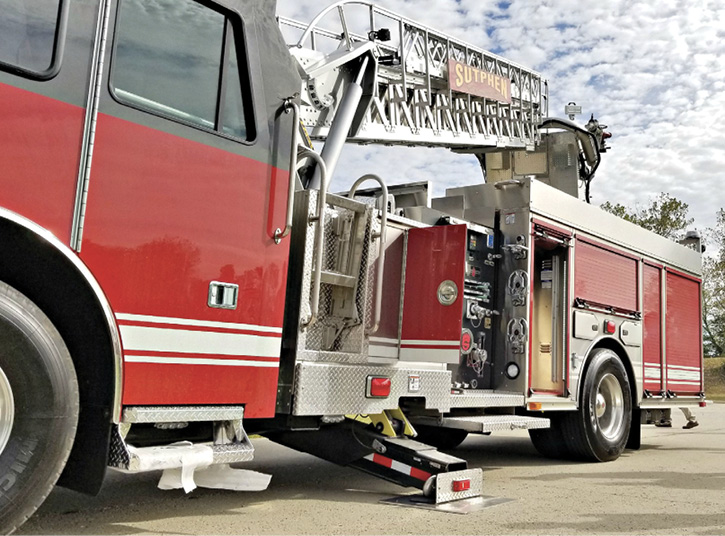
13 Sutphen Corp. builds the SP70 aerial ladder, which has a 16-foot jack spread. (Photos 13-14 courtesy of Sutphen Corp.)
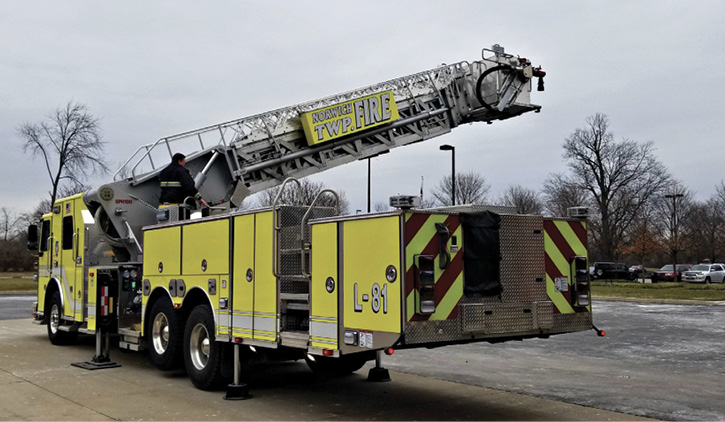
14 This SPH 100 aerial platform built by Sutphen for the Norwich Township (OH) Fire Department is shown operating short jacked from its normal 20-foot jack spread.
“We are traditional midmount aerial ladder builders,” says Tim Lett, Sutphen’s aerial engineer. “With a smaller midmount, you can drive up to the structure and work off the side very well instead of having to back into the scene. Also, single-axle aerials have very low centers of gravity, which makes them very maneuverable like a pumper and allows them to set up in tight areas with a single set of H jacks.”
SPARTAN ER
Randy Hummer, of Spartan ER, notes that Spartan ER aerials comprise the Smeal and Ladder Tower (LT) designs. “The 55-foot rear-mount aerial ladder by Smeal has a 13-foot 6-inch jack spread with two H-style jacks located behind the drive axle,” Hummer says. “On the LT75 ladder tower, the wheelbase is 209 inches, and the jack spread is 18 feet. Smeal has a 212-inch-wheelbase, 75-foot aerial with two H-style outriggers behind the rear axle with an 18-foot jack spread that allow a 750-pound dry tip load and 500 pounds wet.”

15 The Smeal 105-foot aerial ladder has four H-style outriggers that spread to 16 feet, two behind the cab and two behind the rear axle. (Photos 15-16 courtesy of Spartan ER.)

16 The 65-foot TeleSqurt aerial boom ladder made by Spartan ER uses four A-style jacks with a spread of 11 feet 9 inches.
Hummer points out that the Smeal 105-foot aerial ladder has four H-style outriggers spread at 16 feet, two behind the cab and two behind the rear axle, allowing a 750-pound dry tip load and 500 pounds wet. “All of Smeal and LT aerial designs can be short jacked, allowing the aerial to be rotated five degrees past center on the short-jacked side,” he says. But if customers need a really tight setup, they should consider the LT 110 with a 12-foot jack spread, Hummer adds. “If you can open the cab door of the truck, you can set the aerial up within its fully operating envelope,” he says, “full capacity at 360 degrees, and no concerns about limiting extension.”
ALAN M. PETRILLO is a Tucson, Arizona-based journalist, the author of three novels and five nonfiction books, and a member of the Fire Apparatus & Emergency Equipment Editorial Advisory Board. He served 22 years with the Verdoy (NY) Fire Department, including in the position of chief.

